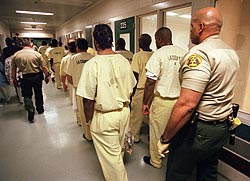|
A man we'll call Mike has been to jail several times. He hopes never
to go back. Mike is a plumber in his mid-40's, a compactly-built
man with a mustache and a firm handshake. His apartment overlooks
Main Street in a small town outside Minneapolis. At 8 o'clock in
the evening Mike looks at his watch and goes to his medicine cabinet.
"Gotta take two of these babies," he says, pulling out
a small bottle of prescription medicine with a satisfied smile.
"They're ten milligrams apiece."
 |
  |
 |
 |
 |
 |
 |
In
most of the nation's jails and prisons, mentally ill inmates get no treatment
unless they cause trouble for jailers. Even then, they stand a good chance of
being sent to solitary confinement, not to a psychiatrist.
AP/Wide World Photos |
 |
  |
Two little pills that make all the difference in Mike's life. He says the antipsychotic
medication, olanzapine, tames the symptoms of his schizophrenia and makes him
feel—almost—normal. "I have the same feelings...I feel and see
things pretty much the way everybody else does."
The trouble is, Mike hasn't always taken his meds regularly. As
a result he's been arrested and locked up three times—twice
for stalking and once for assault.
"Well, he's just hyper! I mean, ready to jump out of his skin."
That's how Mike's father, a retired plumber who lives in a Minneapolis
suburb, describes Mike's demeanor when he's unmedicated and psychotic.
"Like he told me, he says, 'Dad ... you don't know
all the voices you hear and the things telling you what to do.' And he says it goes on and on and on and on."
Mike's mother adds: "He can be talking to you and all of a
sudden he can be staring, like [there's] nobody home, you know.
And he'll just stare a hole right through you. And he's got the
kind of eyes that look kind of wicked when he does that. And that
is what has scared these so-called stalking victims."
In 1995 a woman called police after being scared by Mike's psychotic
gaze. He was sentenced to three months in the Hennepin County Workhouse.
A similar incident with a different woman put him back in jail for
several months in 1998. Between those two arrests, Mike did another
two-month term in a rural county jail for assaulting a deputy sheriff.
When the deputy pulled Mike over on a traffic stop, he argued belligerently
with the officer. The confrontation turned into a chase and a struggle
and a deputy with a bloody nose.
Mike's parents blame his illness.
"If you put [a schizophrenic] in a corner, he'll fight back
just like a cornered tiger," says Mike's father.
"That's the paranoia," his mother says. "They think
that everybody is out to get 'em. Everybody."
So Mike landed in jail. Then, on the inside and still unmedicated,
he got into more trouble. In one incident at the Hennepin County
Workhouse, a guard told Mike to reach through the bars so he could
be handcuffed. Mike refused.
"They maced me and they dragged me off to the isolation cell,"
he recalls, "and they put me in one with no bed, just a mattress
on the cement floor and a TV camera so they could watch me. And
I stayed there for the duration of the time."
Mike spent much of his jail time in solitary confinement. Even
a couple of years later, remembering the humiliation and frustration
makes him weep.
"I didn't get to tell anybody, I didn't get to talk to anybody,
I didn't get to tell my side of the story. And when I would try...they
wouldn't believe me. But they don't have to wake up in the middle
of the night soaking with sweat and staring at the wall and not
be able to think of things, either. I go through that all the time."
Next:
From the Street to Jail, and Back
|

